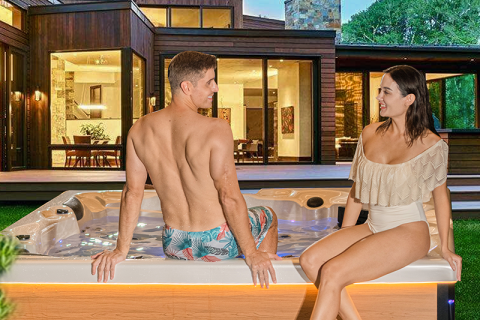
- Home
- >
- News
- >
- Industry news
- >
News
Coughing is a defensive reflex of the respiratory tract, intended to expel irritants, foreign matter, allergens, or excessive secretions from the airways. When someone coughs in a whirlpool spa hot tub, it often indicates that an external stimulus is affecting the airway mucosa or the lungs' sensory system.
In public, wearing a swimsuit is undoubtedly the safest option to respect others, maintain health, and maintain etiquette. In private, however, you can choose whether to wear one based on your personal preference. The ultimate goal is to ensure a comfortable and safe spa jacuzzi bathtub experience that is both personal and appropriate.
The requirement that a spa jacuzzi bathtub must be perfectly level stems from a comprehensive consideration of equipment performance, user safety, pump efficiency, and long-term maintenance costs. Whether for home or commercial use, the installation process must strictly adhere to leveling requirements. Never overlook this seemingly minor, yet crucial, technical step.
Acrylic spa tub crack repair process Step 1: Clean the cracked area Step 2: Sand the surface Step 3: Apply repair agent Step 4: Natural or heat cure Step 5: Fine sanding and polishing Step 6: Apply protective oil
The frame design of an outdoor spa hot tub is based on "bottom-load bearing." The bottom ground plane typically utilizes reinforced steel frames and support legs, capable of bearing the weight of the unit and the weight of people in use. The side structures serve only to maintain the integrity of the tub and are far less resistant to compression than the bottom.
When we ask, "What do you put in your spa jacuzzi bathtub after each use?" the answer isn't just "disinfectant"; it should encompass a comprehensive set of cleaning and hygiene practices. Chlorine-based disinfectants, oxygen-based disinfectants, and specialized system cleaning solutions—each solution has its own applicable scenarios and technical requirements.
A whirlpool spa hot tub that can truly accommodate seven people is typically approximately 2.2 meters by 2.2 meters, requiring at least 5 square meters of floor space. Including the surrounding space, the recommended floor space is 7-8 square meters.
A tub can fit through a doorway smoothly if one of the following conditions is met: · Doorway width ≥ the tub's dimensions on either side + cushioning ≥ 100 cm; · Height ≥ the tub's longest side (usually width or length); · The path is straight and unobstructed, with a turning radius that allows the unit to pass through at an angle; · Doorframes and guardrails can be removed to expand the space; · An alternative to hoisting is available.
Yes, lowering the temperature of an outdoor spa hot tub can save money. These savings are reflected not only in your electricity bill but also in equipment longevity, water quality maintenance, and energy efficiency.
Generally speaking, for a large, standard-sized outdoor spa jacuzzi tub (approximately 2.2 meters square), six to eight people are recommended for ground handling. For high-altitude installation or in complex terrain, this number should be increased to eight or more people, using a combination of lifting equipment and a sliding rail system.
· Heating time is affected by multiple factors: water volume, initial temperature, power, environment, and insulation structure. · Typical heating time: In winter, heating from 10°C to 38°C takes approximately 4-5 hours (2kW unit). · Practical Tips: Book in advance, maintain a tight seal, and choose the right climate.
General Power Recommendations For typical 2-person outdoor spa hot tubs, the water capacity typically ranges from 300 to 600 liters. Within this capacity range, a heater power of 3 kW to 6 kW is generally recommended.












